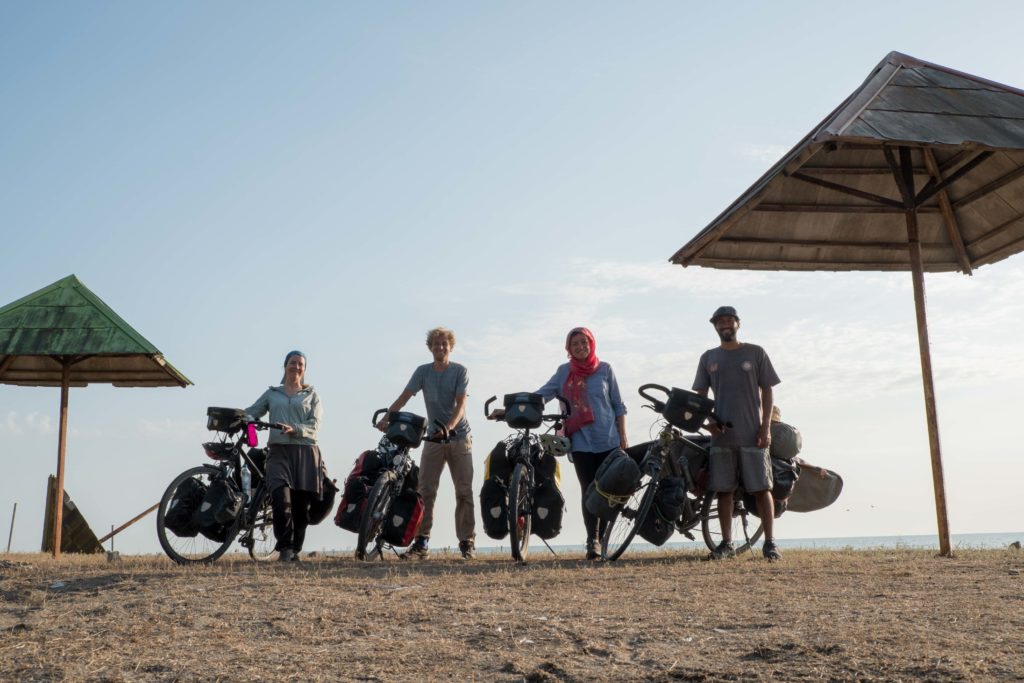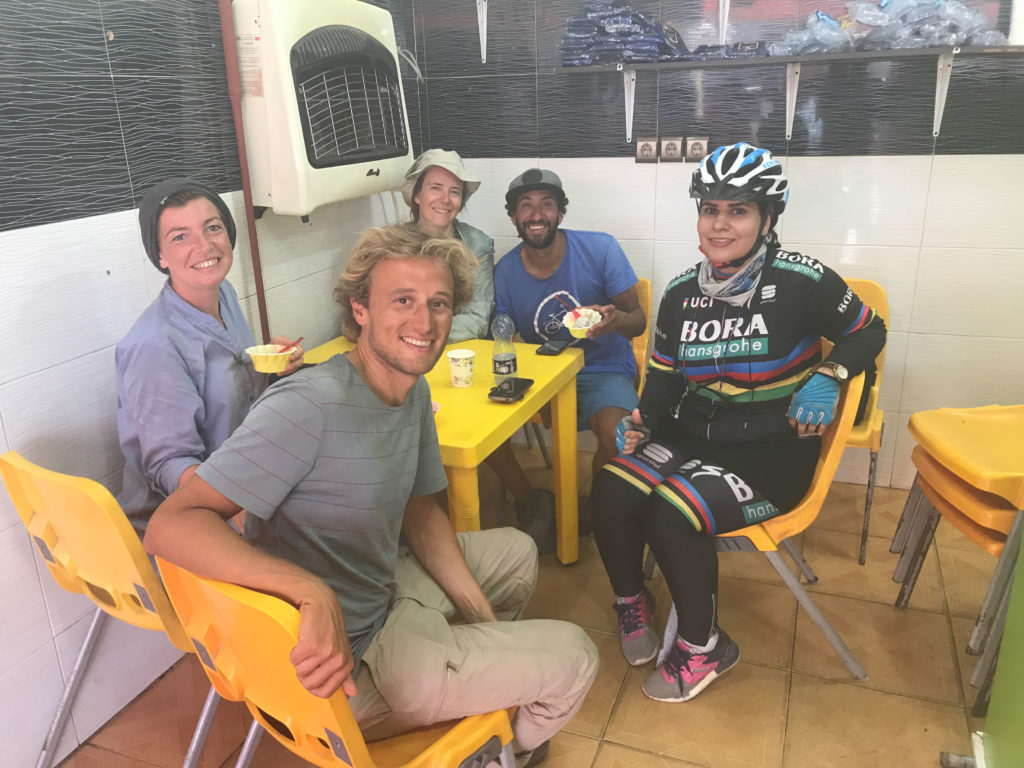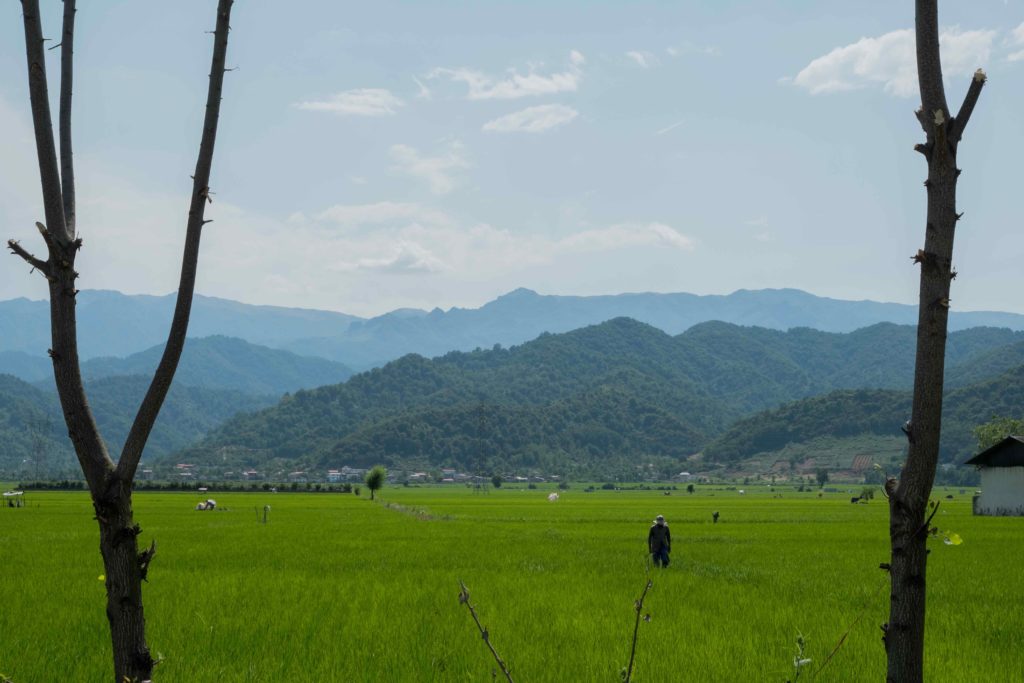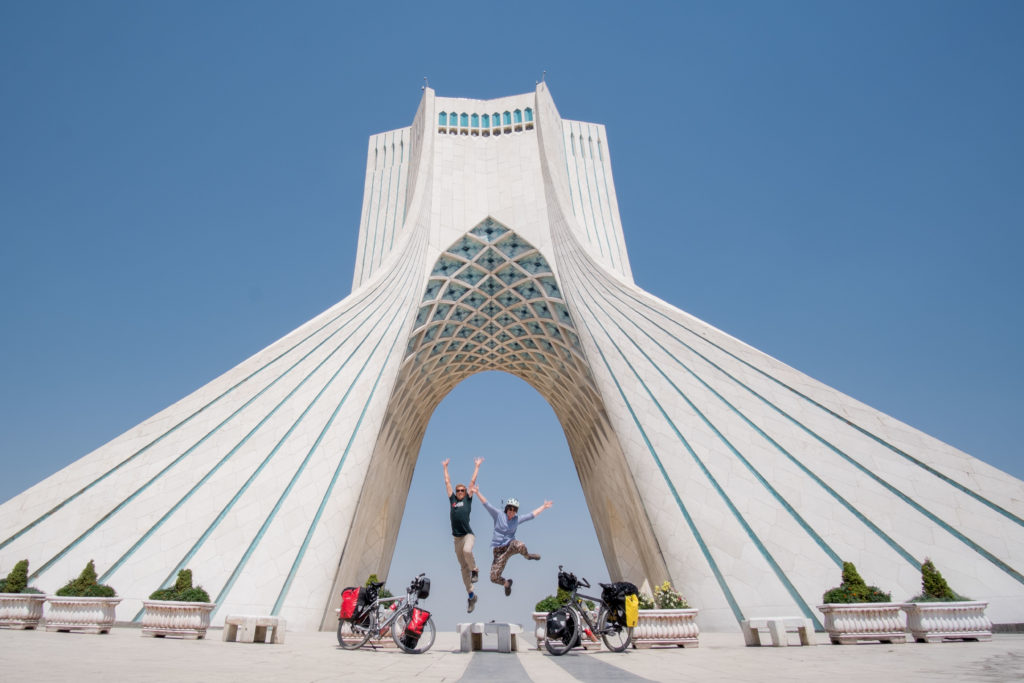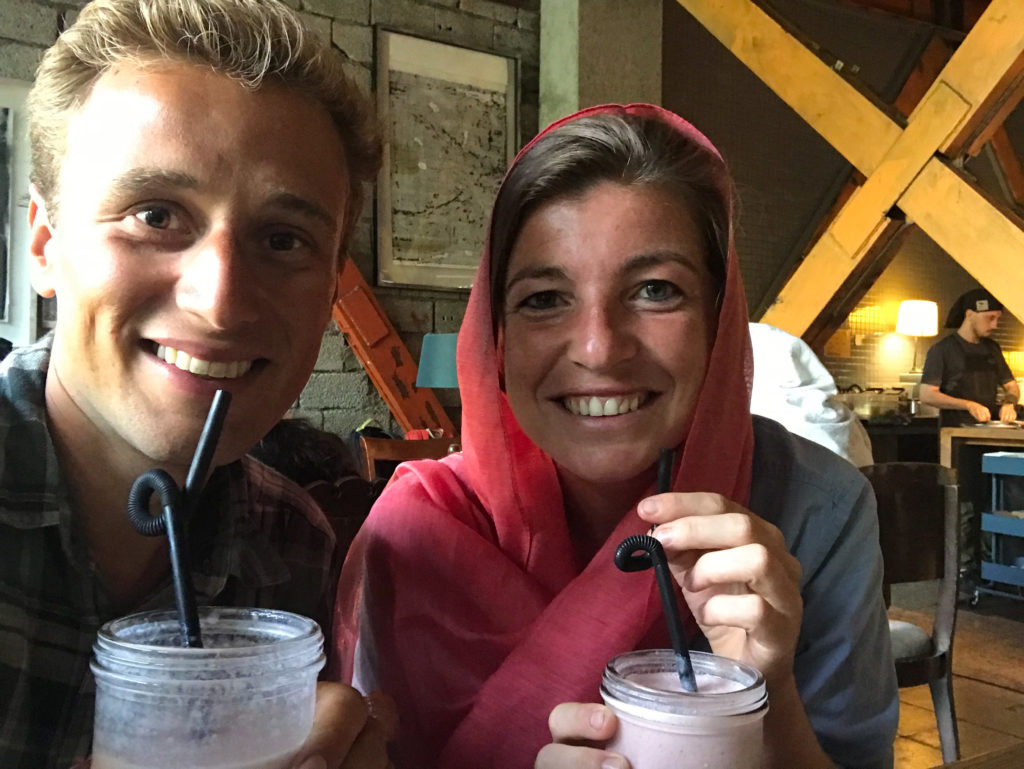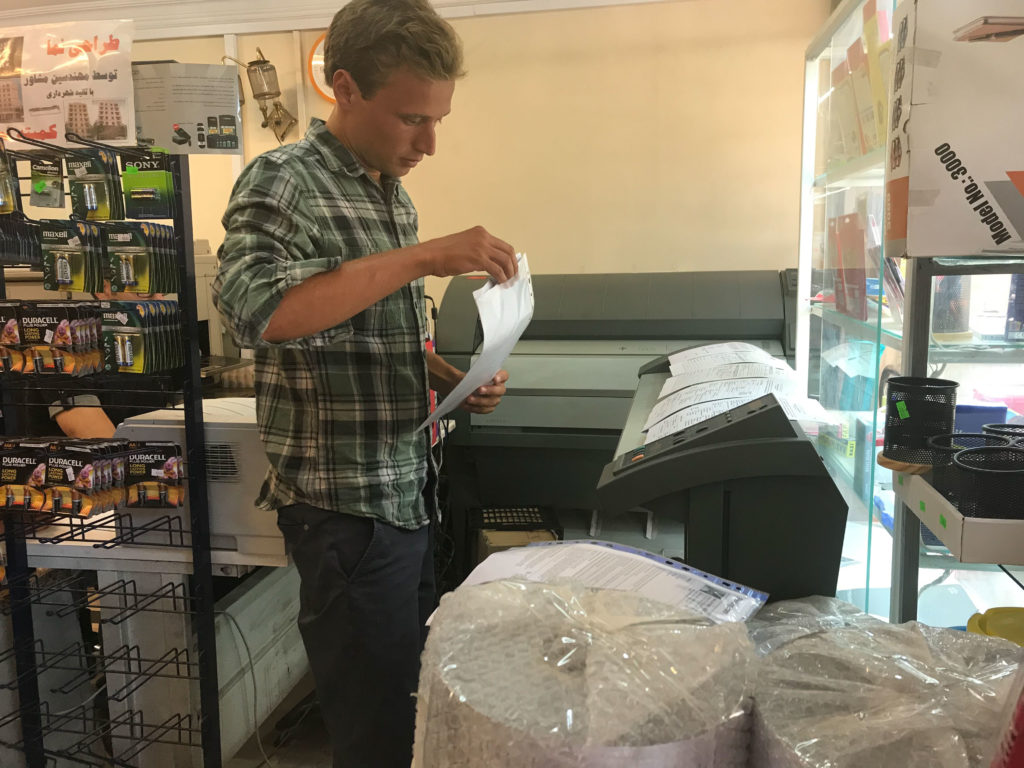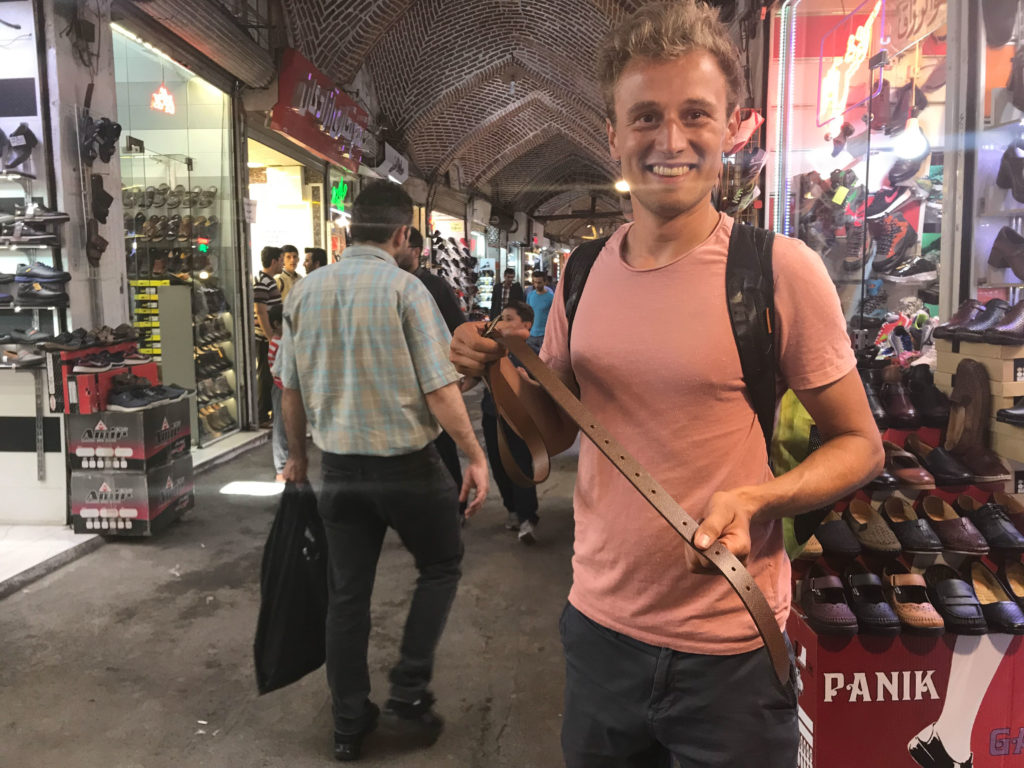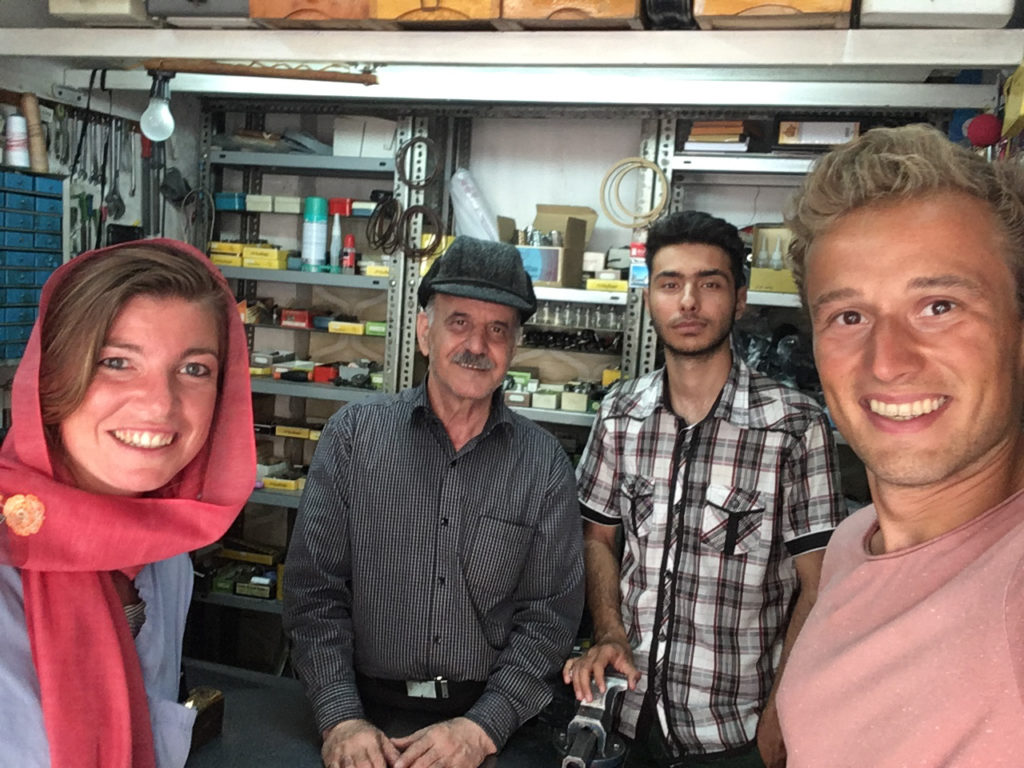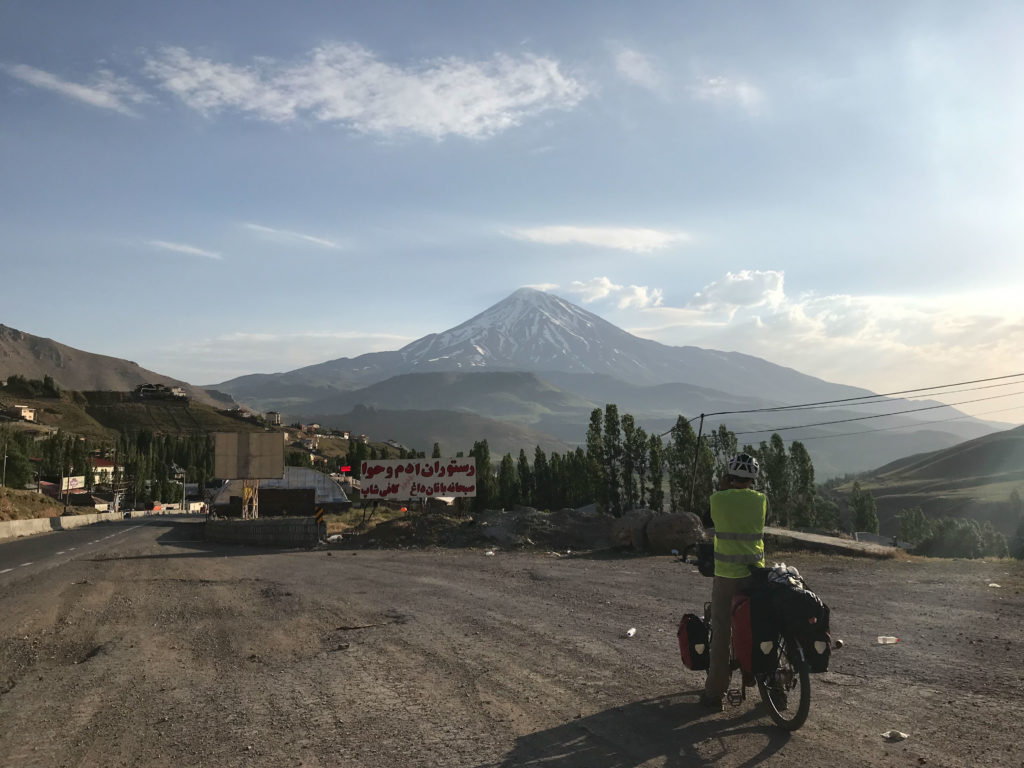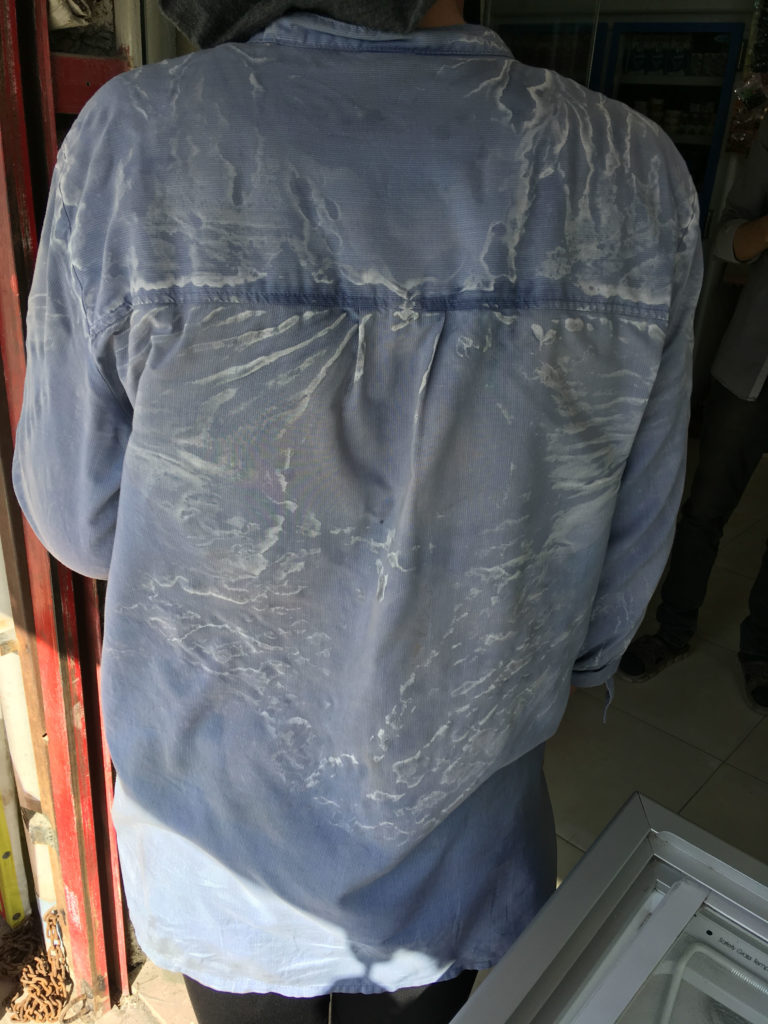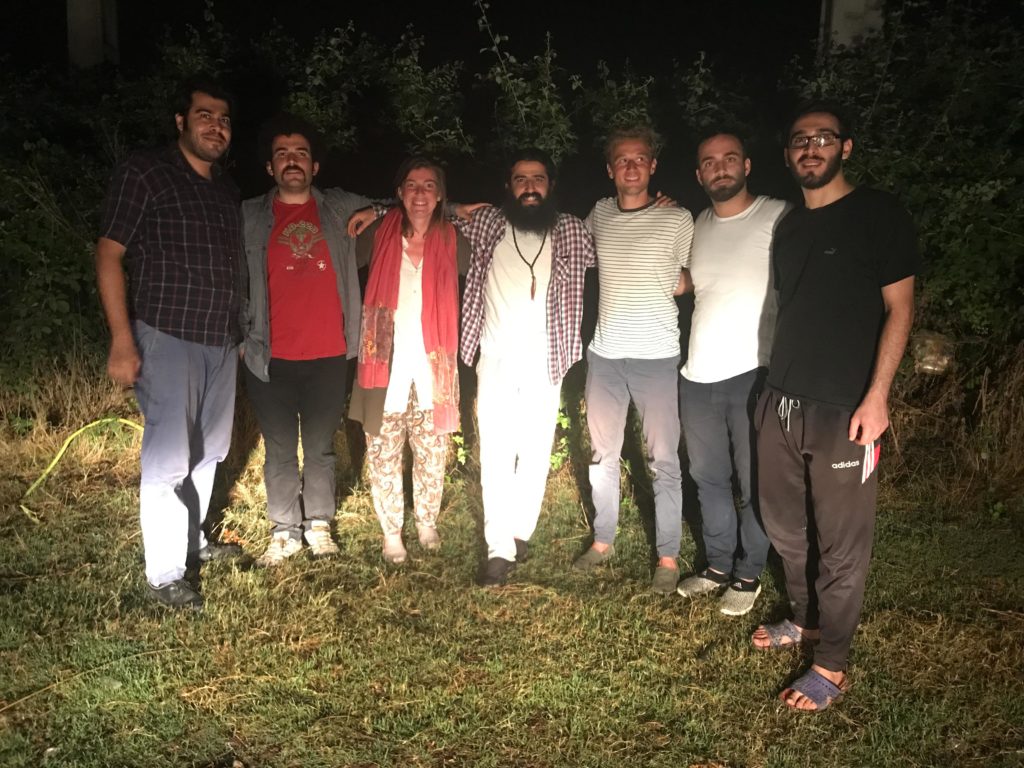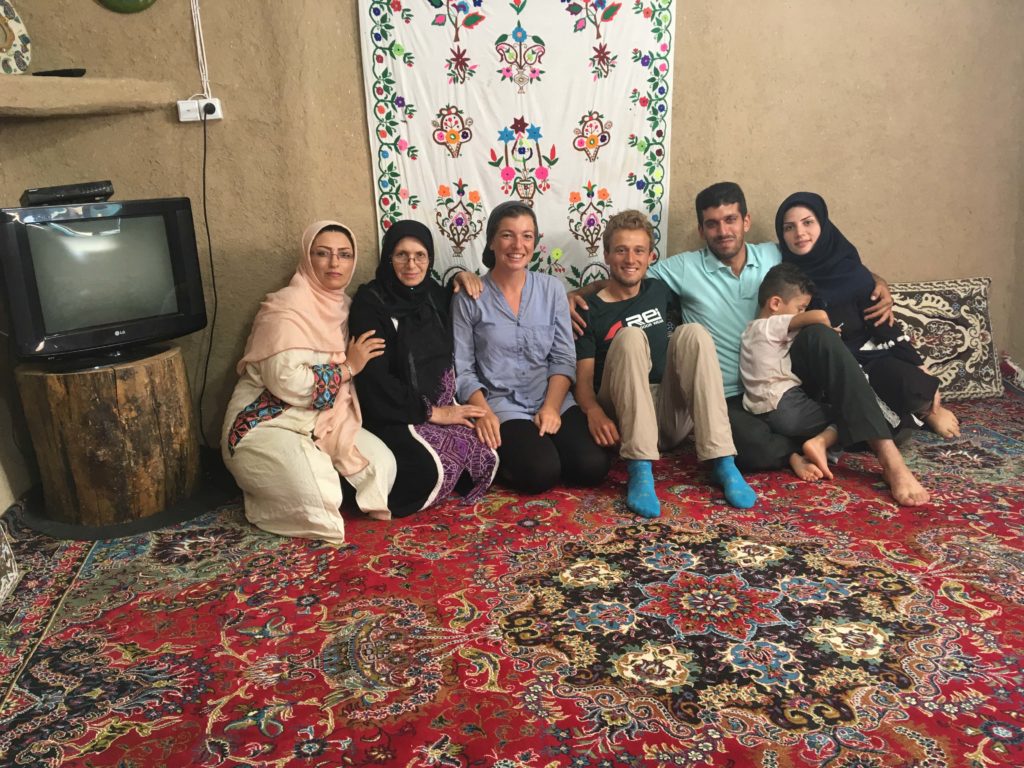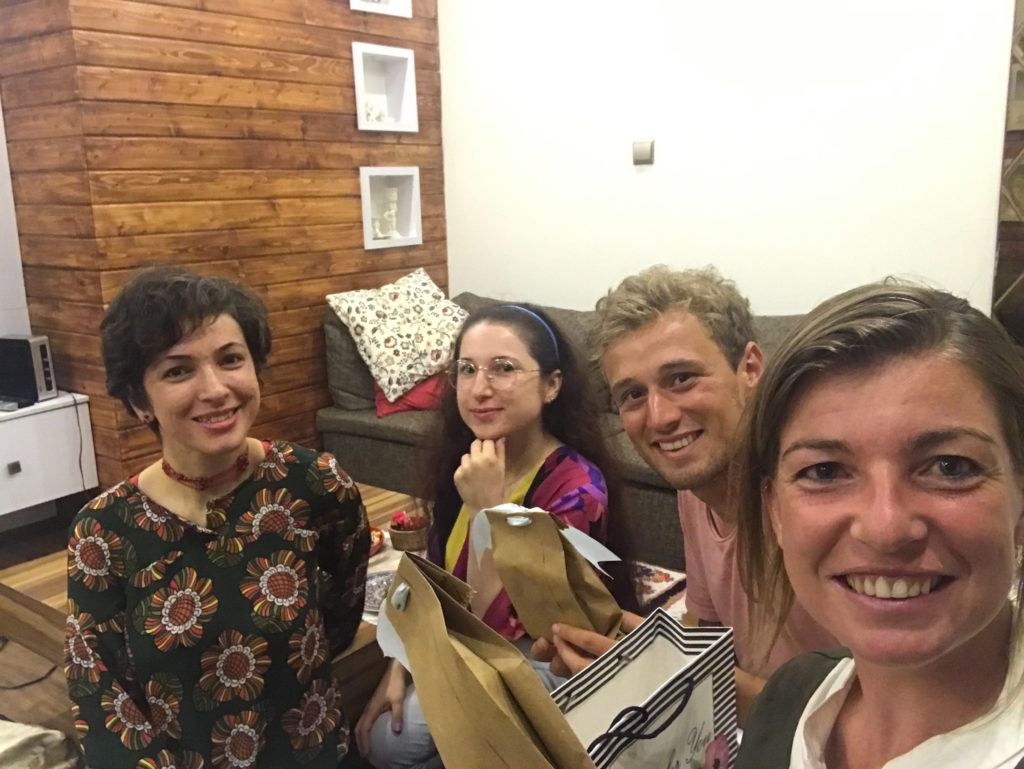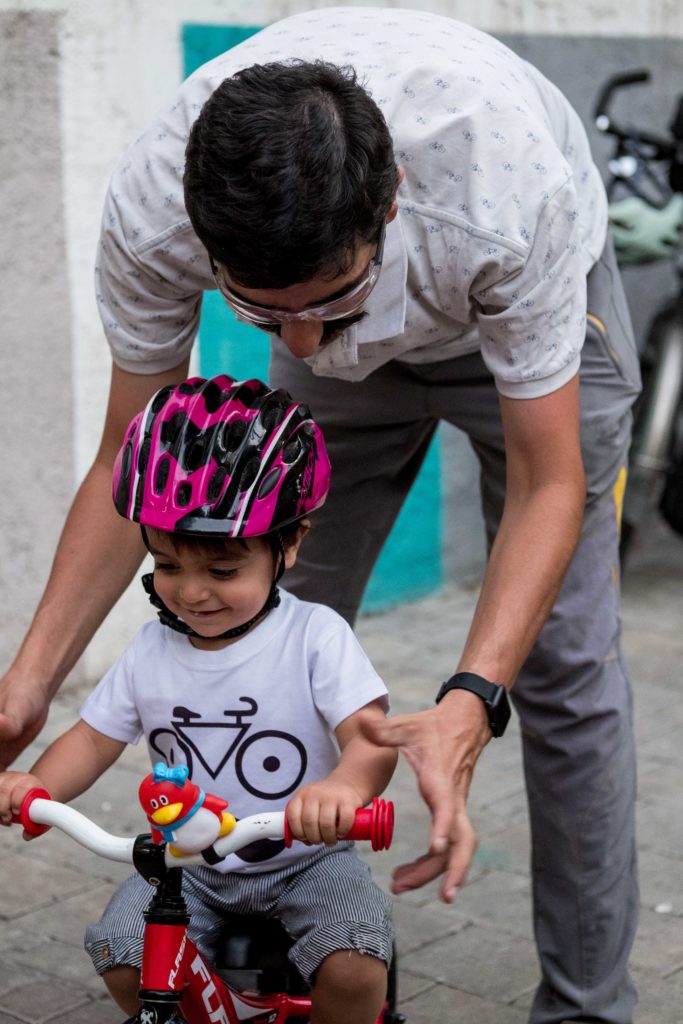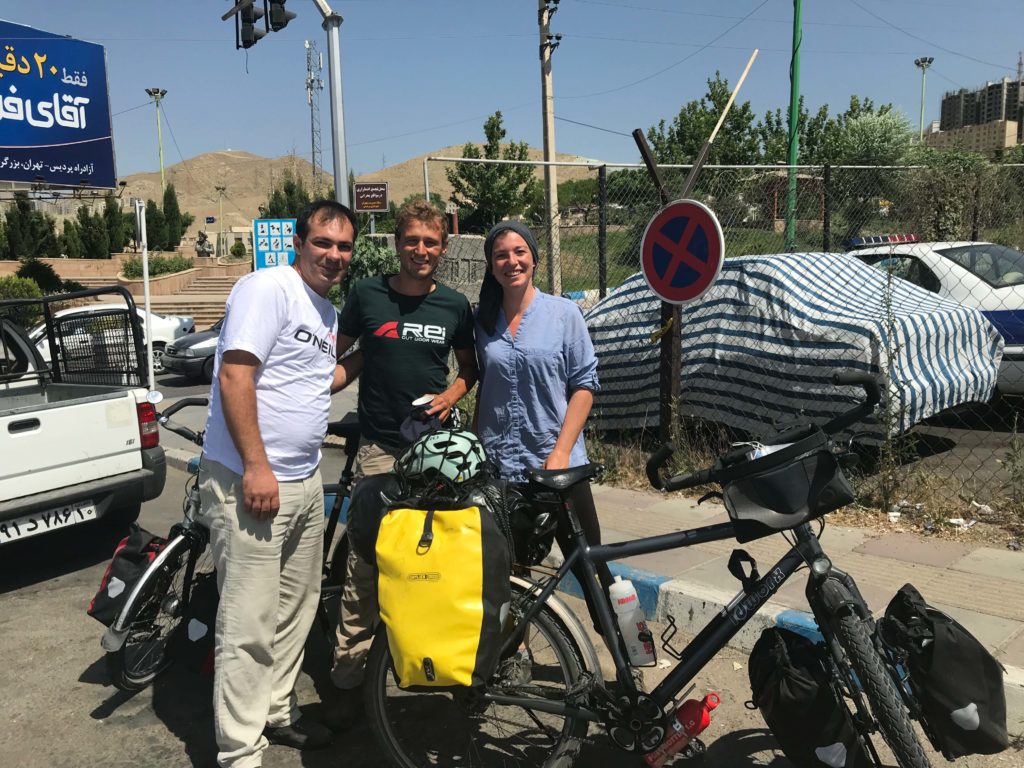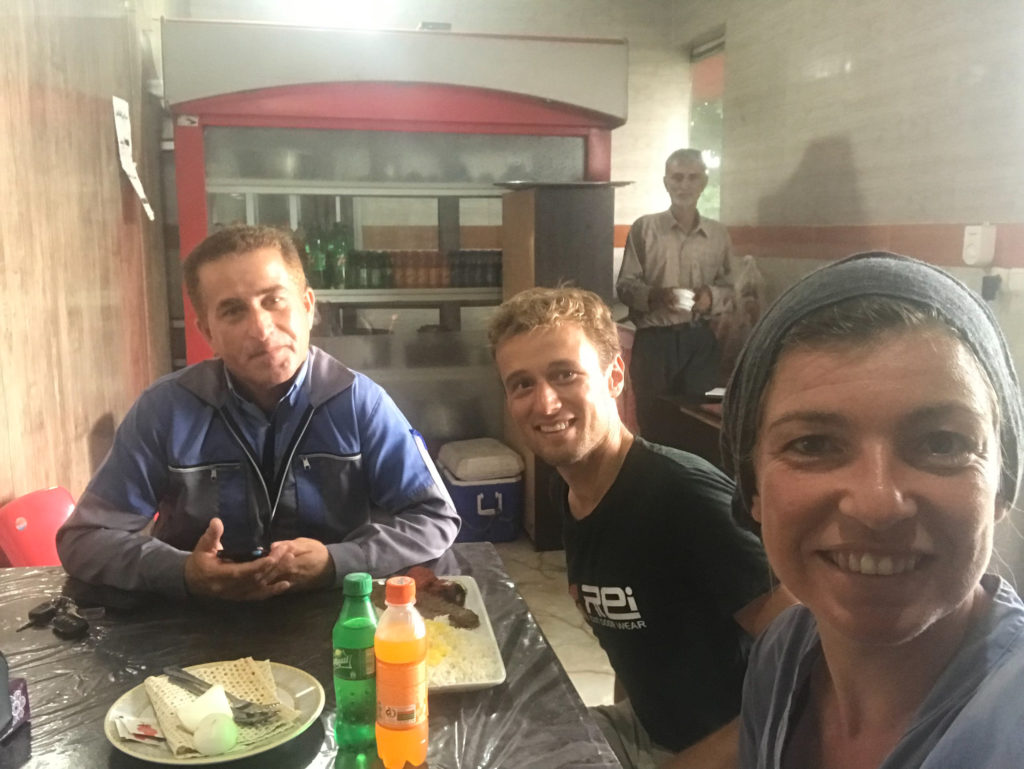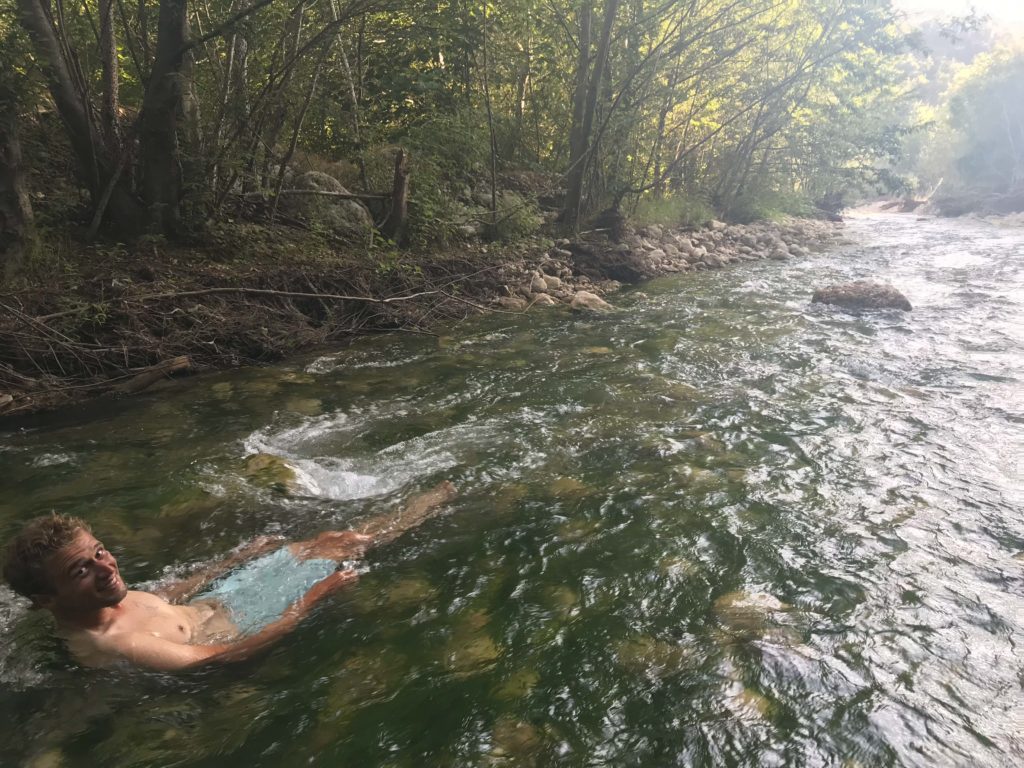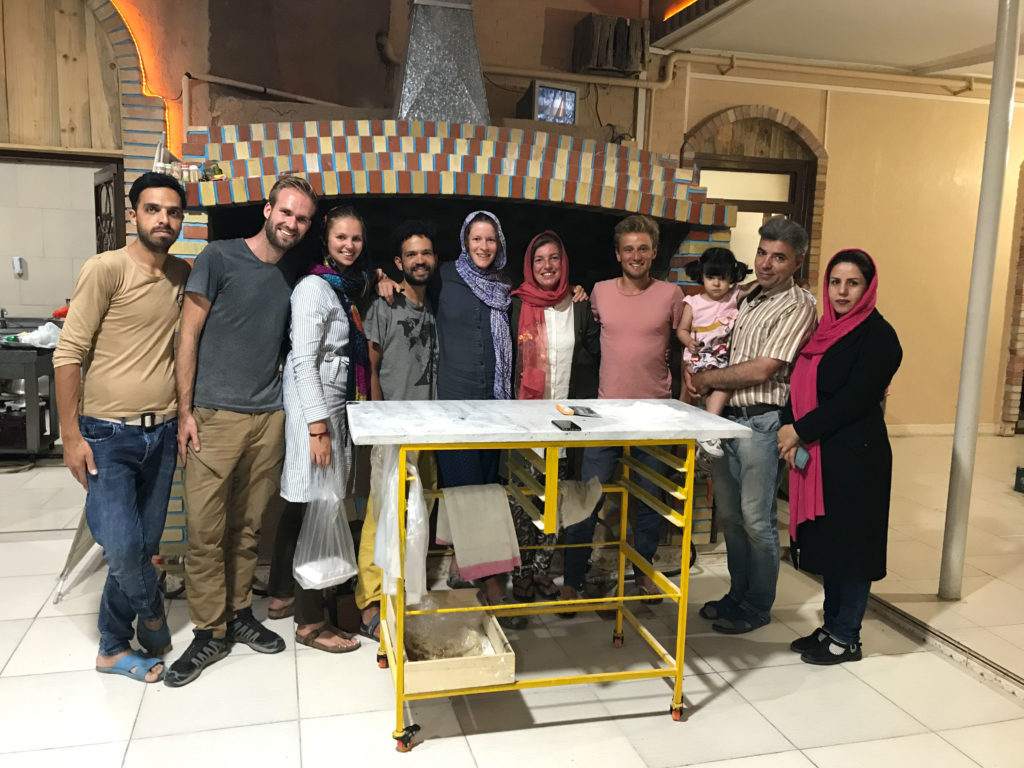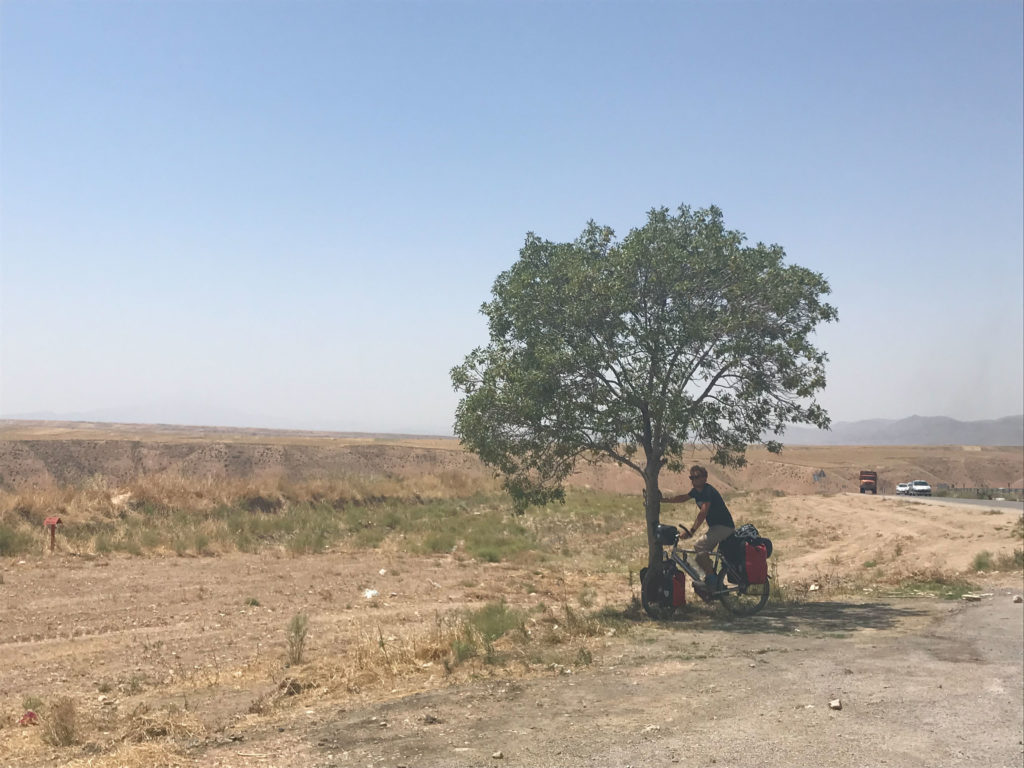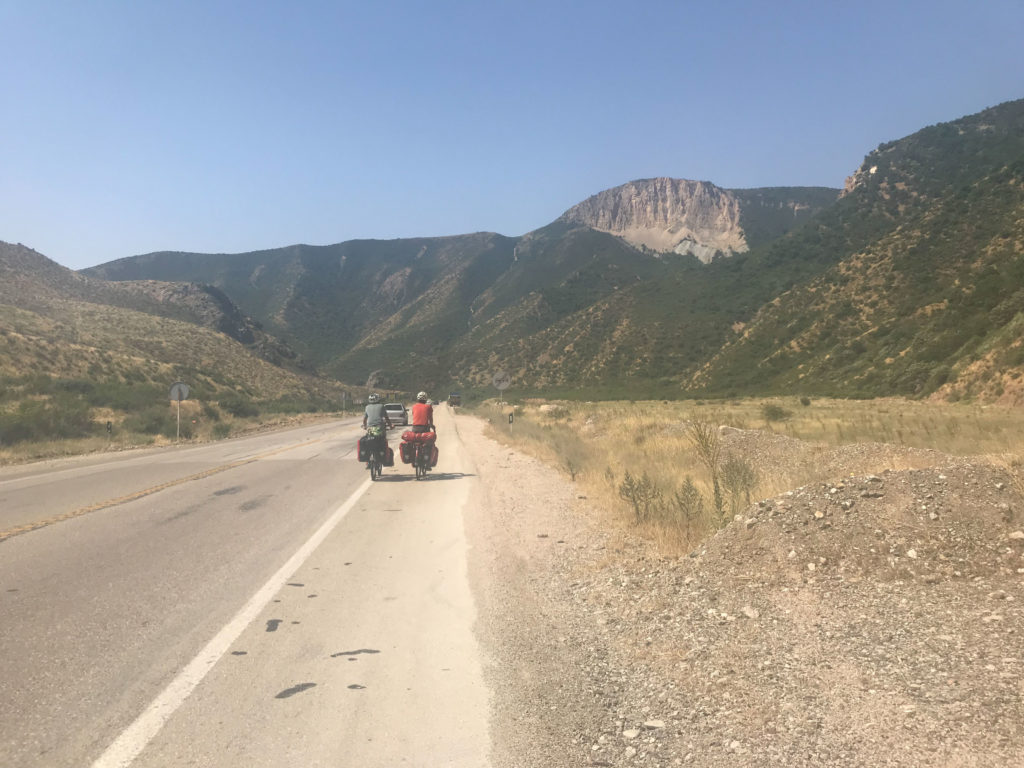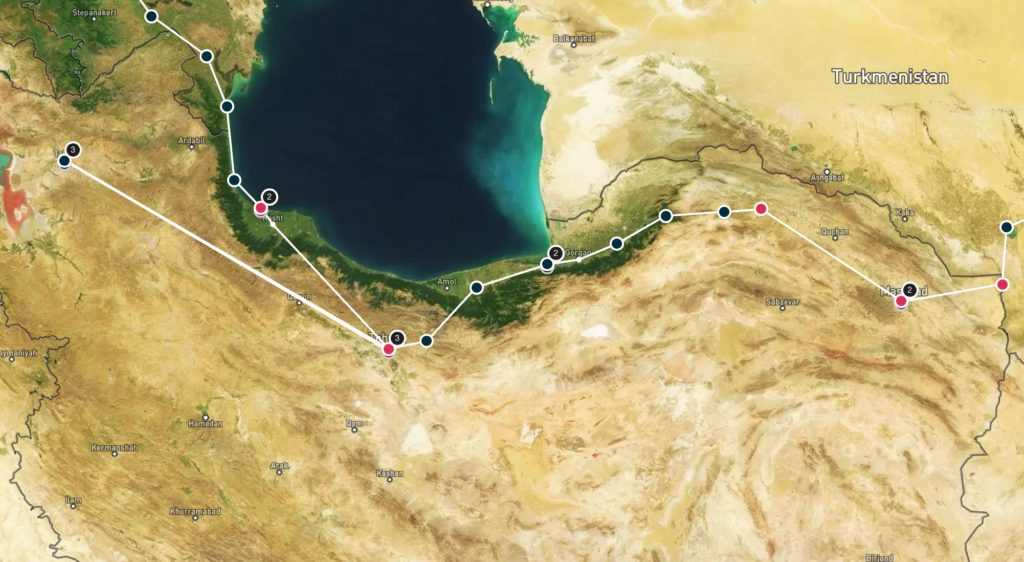Astara (IR) – Serakhs (IR) / 6866 km / 3.35 Million Turns / June 19th – July 9th, 2019
Sometimes it takes a few seconds between seeing something with your eyes and actually constructing the picture in your mind. While doing groceries on the side of the street, from the corners of our eyes we noticed a long flat thing gliding past… Turning around, it was unmistakably a surfboard. In Iran? But where are the waves? Both of us only saw the complete picture some moments after: the surfboard was also attached to a bicycle! Just in time, we managed to wave hello and make contact. It indeed turned out be bicycle/surfboard combination, carried right through the Iranian desert by Lesther from Venezuela, cycling for multiple years with his Swiss girlfriend Stefanie.
Now there are certainly more useful things to carry around in Iran than a surfboard, but after hearing their stories it did make quite some sense; cycling and surfing were a perfect match in Mexico, Turkey and Cyprus where the couple had already been. And if all you possess has to be carried by bike, then heck, why not tag the board along through the desert! We rode our first days in Iran together with these two and had a great time together. Maybe a trailer with surfboards isn’t such a bad idea if we ever make it to the Australian coast.
Iran, a country bit less unknown to us since we’d been here two years ago, but still full of surprises nonetheless. Compared to our first visit, a few differences were noticeable right away. For instance, this part of Iran (along the Caspian Sea) is a lot greener than the rest of the country. So green actually, its rice paddies and fruit orchards are almost indistinguishable from South East Asian landscapes. Also, Iranian currency, already worth next to nothing in 2017, devaluated three times more now, so 1 Euro would equal about 150000 Rials. Our wallets were too small to carry all the notes, and so in Iran we carried it around in a resealable plastic bag. And in Tehran, women’s headscarfs were set an inch more back than last time, showing that at least in affluent parts of the capital, there was a little (but just a little) more leniency in Iran’s dress code. However, most things remained the same, such as the crazy traffic, the heat, but most of all the wondrous Iranian hospitality.
After arriving in Rasht, the centre of the green Gilan province, we took a bus to Tehran, where we needed to arrange our Chinese and Turkmen visas. After another day of filling in form after form, copy after copy, and making sure our photographs were not 45×35 mm but 48×33 mm (yes, those are the requirements), we were finally able to hand it both applications. We celebrated our successful bureaucracy day by spending our day in Northern Tehran hipster coffee bars and drinking flat whites, cucumber basil mint juices and eating chocolate cakes. In one of those bars we actually drafted the very first ideas of our cycle trip, back in 2017, sketching our route on some paper napkins. Now, less than two years later, we were back at the same table and got here via the route drawn back then!
As it took some time to process the visas, we escaped the smog-filled air of Tehran for a while and took a bus to Tabriz, the only larger city in Iran we hadn’t yet visited. Although there are not many big highlights except for the largest bazaar in the world, it was a pleasant rest period where we could unwind a little. One of the little highlights of the day was the shop of Ali, who ‘collects’ tourists visiting the city. All foreigners are invited for a cup of tea in his sewing machine shop and requested to write something in his guest book. These books now filled half the book rack. Another essential to-do was buy a new belt for Tom, who despite being able to eat a chicken for lunch still seems to lose weight.
Back in Tehran, we got back on our bikes again. Our route would take us right along Iran’s highest mountain, Mt. Damavand (5610 m) and then right down to probably the lowest point of our trip, -20 m below sea level near the Caspian Sea. Here, we were back in Iran’s green garden, but the heat, and specifically humidity, made cycling more than ever before a sweaty business. We resorted to our usual siesta rhythm of travelling early in the morning and late in the afternoon to avoid the hottest and most humid hours.
The cycling itself from Tehran to the Turkmenistan border was in terms of scenery not really a remarkable ride. Unfortunately, there are not many options to take smaller, quieter roads in this part of Iran, so this meant riding on busy highways for most of the time. Combining this with the sweltering heat, exhaust fumes, crazy driving and non-stop honking made it quite an intense ride. Other routes more south were not an option for us either, as the mid-summer temperatures (45 degrees) here were not exactly appealing. We would have plenty of that later on.
Iran’s people however, do make up a lot for the somewhat dull scenery. The country has a long tradition of offering hospitality, and we were met with a great dose of it (of which sometimes too much, later more on that). No matter where you are, there would always be people approaching you, just to greet you, have a chat, but often giving your food and drinks. We were invited for tea and for a place to sleep multiple times per day most days. As is good etiquette in Iran, you have to decline every offer at least twice (Taarof), before making a giant U-turn and accepting an offer. However, looking at our red and overheated faces, we think many Iranians did not mind us accepting a cold refreshing drink the first time already ;). It is heartwarming to see how open the people are towards foreigners and how they invite you to their homes as if you have known them a long time.
Via these invitations and Warmshowers, we got to meet a great deal of Iranians. A group of friends chilling in their ‘Kings Landing’ shelter in an orchard, two very creative sisters working as photographer and fashion designers, a gas station manager, a cycle-touring family travelling with their baby on the bike, with over 80 million people in a country there is not a single ‘typical’ Iranian, and the ‘typical’ Iranian is definitely not the person we see on the news in the West.
Overarching our visit was the political tensions with the US. The first day we were in Iran also was the day the Iranian army shot down the US drone and the conflict nearly escalated. Although there wasn’t any unrest on the streets itself, it was a little surreal to be having your holiday here while in almost all media channels it looked like war was imminent. We got many messages from friends and family back home, asking if we were alright or if we noticed anything from the tensions. But we never felt unsafe during our time in the country, fortunately. On Iran’s streets, life was being lived as on any other day.
It was hard for us to gauge how Iranians themselves thought about the conflict. It seems many people we met opposed the government greatly, but due to the secret service spying a lot they could not say so explicitly. We even heard some supported Trump, since they thought that a change due to war was better than no change at all. It was sad to see that the people themselves, and not the government, were the ones suffering from the economic sanctions. Unemployment was soaring, money was worthless, opium use on the rise.. Iran’s government, with its oppressive rules for women, minorities and free-thinkers couldn’t be more distant from the hospitality and kindness we were met with during our time there.
As a word of advice to future selves and other cyclists: When entering Iran, make sure your energy levels are charged as fully as they can be. As hospitability is also the people’s greatest virtue, it can sometimes also be draining on your own energy levels. Hospitability as some people even goes so far that they can be quite forceful about you accepting their offer, and if you decline, taking it as a personal insult. (“No, we will not sleep at your place for a week, thank you, we have just cycled 10 km and still want to get somewhere today. No, thank you, maybe next time. No, also not one night. No we will also not stay at your uncle’s place in the next city, we would like to be alone for a night”).
The balance between being a guest and trying to keep our energy levels up was sometimes difficult for us. Writing this, it almost sounds selfish. But especially with people who are not accustomed to cyclists, it can be hard to sort of keep a schedule. Explaining you want to leave early due to the heat and that you have a schedule due to your visa and other plans is sometimes hard to explain. Iranians often eat late (around 11 PM or midnight) so getting up at 6 AM to start cycling left almost all cyclists we met sleep deprived. In one case, we even pulled a Houdini goodbye since our host pretty much demanded us to stay another day. Good stories in the end, but energy draining while there. “En Iran, vous n’êtes jamais seuls” one of our host said (who studied French for several years)
During our last week in Iran we teamed up with Sarah and Pedro, cycling from Portugal to the East. Although the road was still long, straight, and hot, it was great to do this with the four of us. We shared many ice-creams and laughs. They took another border crossing through Turkmenistan but we’d surely meet again at the other side (which we did). The last days in Mashhad we met up with Dries and Manon from Belgium and decided to tackle the Turkmenistan desert together. The country feared by many cyclists, due to its 50 degree heat, headwinds and 5-day transit visa for 500 km. Although all a little sleep deprived from the weeks in Iran, our morale to tackle this country with the four of us in a Benelux peloton couldn’t be higher. More about that in our next blog!
Talk to you soon,
Tom & Sabine


